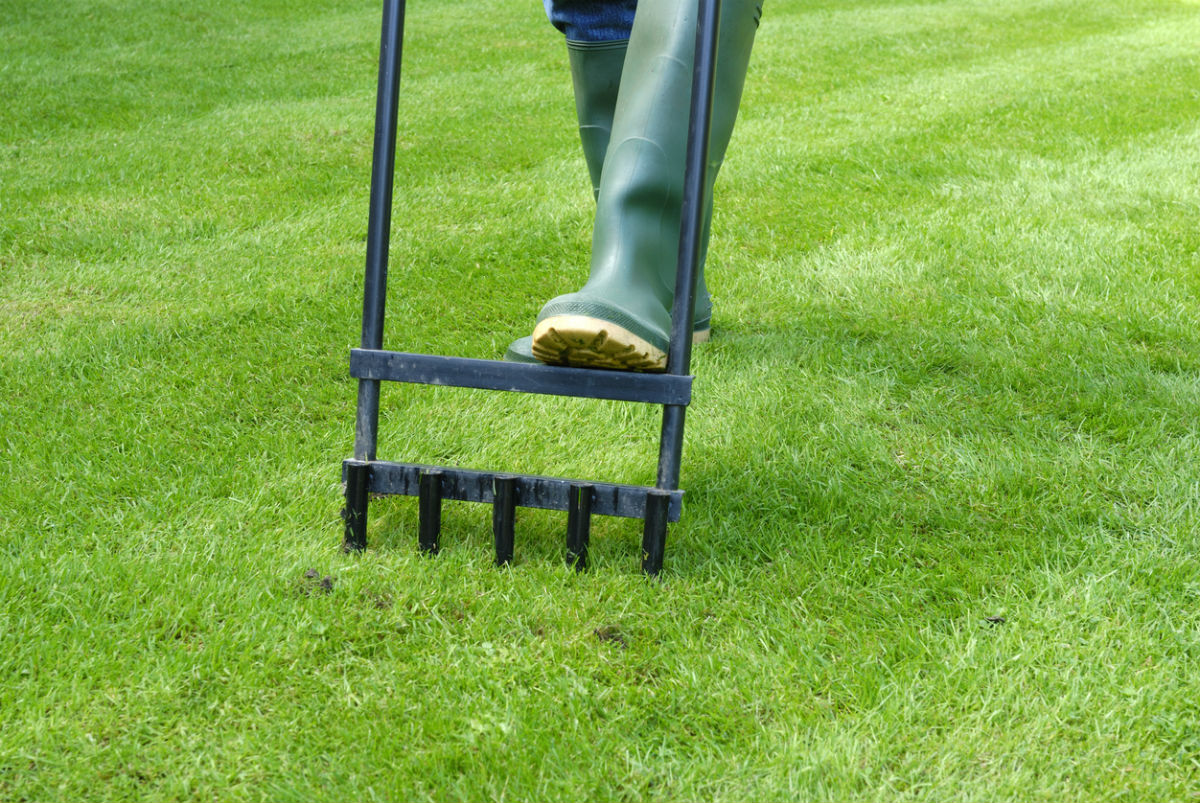

We may earn revenue from the products available on this page and participate in affiliate programs. Learn More ›
Q: I recently moved down south from the Northeast and want to keep my new lawn healthy. When is the best time to aerate the lawn?
A: Punching holes into the soil with a lawn aerator, a tool that has either solid spikes or hollow tines, improves the flow of air, water, and nutrients to your lawn. Aerating also solves such problems as soil compaction (an increase in soil density and decrease in soil volume) and excessive thatch (an overly thick layer of dried plant material between the green blades and roots of grass).
Simple though the process may sound, aerating your lawn properly requires perfect timing. Aeration schedules differ for lawns depending on grass type, soil, and usage habits. Read on to learn about the factors to consider when determining when to aerate your lawn.
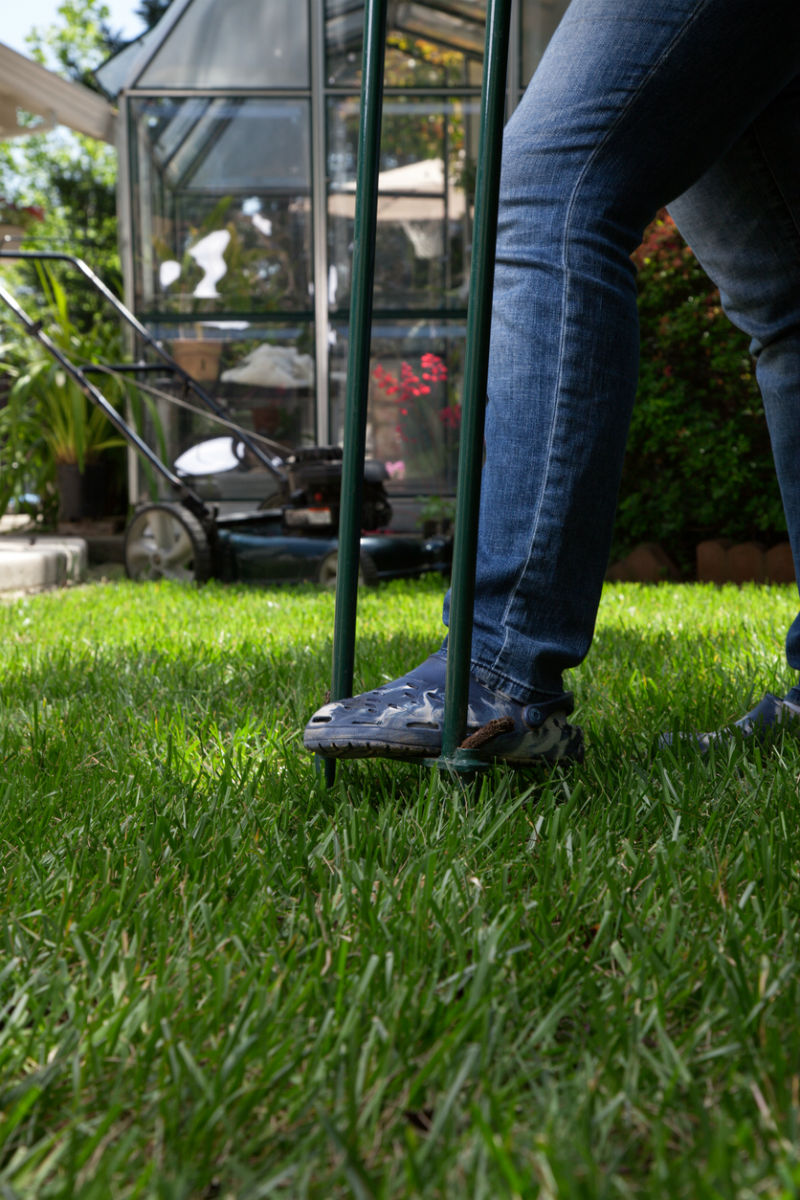
Aerate when turf problems arise.
Why aerate a lawn? While there is value in aerating a healthy lawn to help keep turf lush and green, aeration confers the most benefits on turf that exhibits any of the following conditions:
- Dry and/or hard soil. A classic sign of soil compaction is when a lawn feels bone dry and dense to the touch and rock hard underfoot. You may also have difficulty inserting trowels or shovels into the soil. Aeration increases soil moisture and softness by providing grass better access to water.
- Uneven growth. If the lawn contains bare patches where neither grass nor weeds grow, the soil beneath these areas is likely to be compacted. Aeration promotes even growth by providing grass better access to water, nutrients, and air.
- Poor drainage. Rainwater or water from irrigation often pools in low areas of the lawn because it cannot permeate compacted soil. Aeration improves drainage by improving soil’s absorption of water.
- Excessive thatch. To judge your lawn’s extent of thatch, remove a 1-square-foot, 4-inch-thick slice from the top with a shovel. If the thatch layer is more than ½ inch thick, aerate the lawn. Aeration reduces thatch buildup by boosting the activity of soil microbes that decompose thatch.
- High traffic. Aeration can reduce soil compaction in lawns that frequently get trampled by heavy equipment (e.g., riding mowers) or foot traffic from pets or children.
RELATED: 7 Things Your Lawn May Be Trying to Tell You
The best season for lawn aeration depends on the type of grass you have.
To ensure that holes in the turf left by aeration are quickly filled with new grass, aerate the lawn only in seasons marked by high grass growth, which vary by grass type:
- If you have a cool-season grass, such as bluegrass, ryegrass, or fescue, aerate in the early spring or early fall. Cool-season grasses commonly grow in regions that experience cold winters and hot summers (e.g., Northern California, the Pacific Northwest, the upper Great Plains, the upper Midwest, and New England).
- If you have a warm-season grass, such as St. Augustine, Bermuda grass, or buffalo grass, aerate in the late spring or early summer. These grasses more commonly grow in the warm climates of the Deep South and the lower Southwest and Southeast.
Lawn aeration should not be done during periods of extreme heat or drought, since creating holes in the soil at these times can expose it to more heat, which can further dry out your grass. The best time of year to aerate lawns can also vary from year to year depending on the weather, so always aerate based on what you see in your yard rather than just going by a date on the calendar.
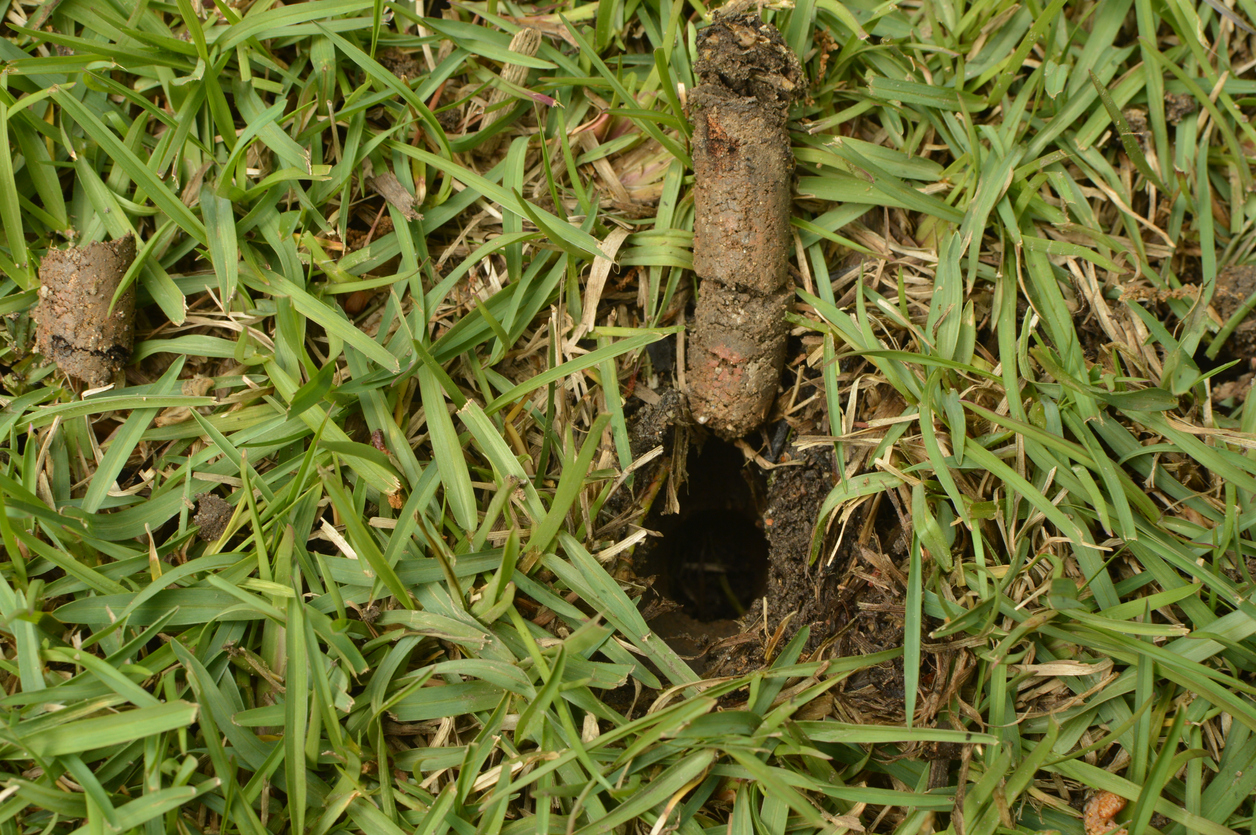
Aerate moist soil in the morning.
Plan to aerate when the soil is moist but not saturated (meaning no liquid is pooling on the soil surface), ideally 1 day after rainfall or irrigation. Whether you use a lawn spike aerator equipped with solid wedge-shaped spikes that punch holes in the soil or a core aerator equipped with hollow tines that remove soil, your lawn aerator will penetrate more easily—and can create deeper holes—when the soil is moist.
Aerate in the morning, if possible, as the low temperature and high humidity will prevent moisture in the grass from evaporating.
Determine aeration frequency based on soil type and lawn traffic.
The frequency of aeration depends on the type of soil you have and the level of traffic your lawn gets:
- If you have clay soil or a high-traffic lawn, aerate the lawn once or twice a year; this type of soil compacts the most easily.
- If you have silty or loamy soil, or get moderate lawn traffic, aerate the lawn once a year.
- If you have sandy soil or a low-traffic lawn, aerating the lawn every 2 or 3 years is sufficient; this soil seldom compacts, so it requires infrequent aeration.
RELATED: 11 Ways You’re Accidentally Ruining Your Lawn
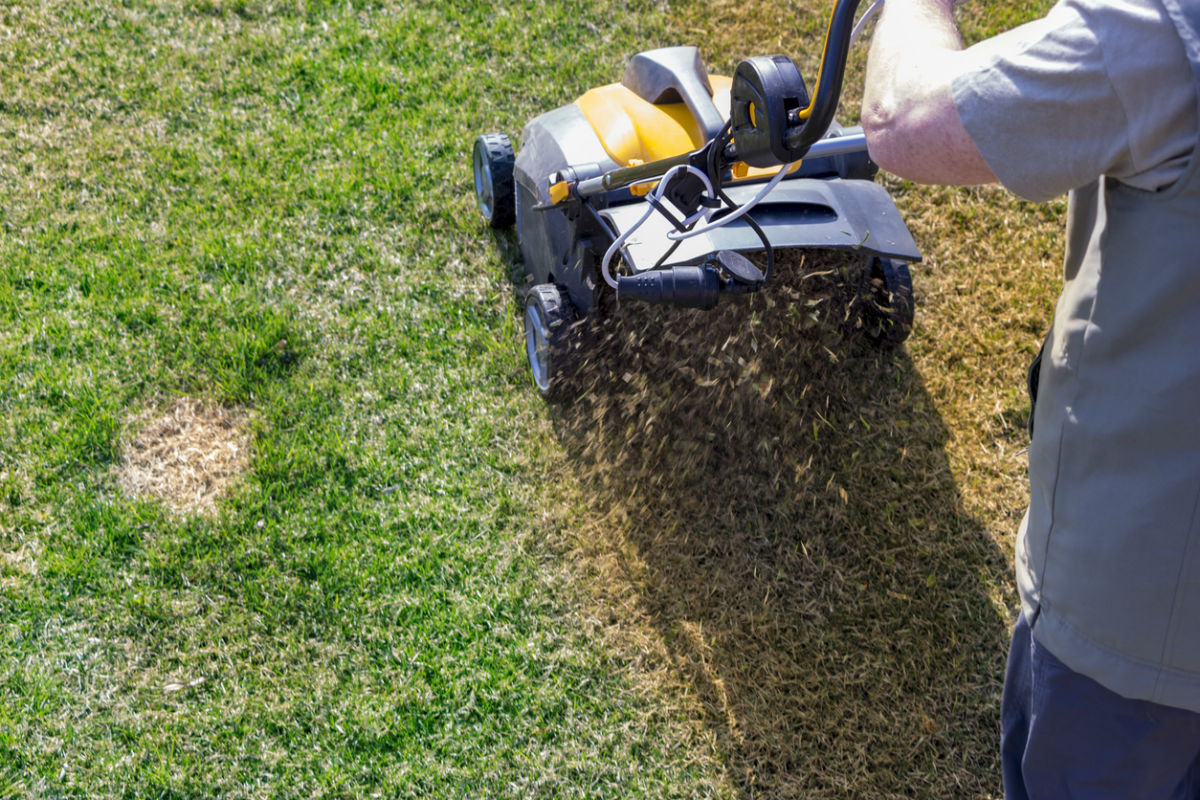
Time aeration around other lawn care tasks.
Be sure to choose a time for aeration that won’t interfere with other lawn-care activities:
- Weed control. While research has shown that aerating your lawn after the application of a pre-emergent herbicide will not hamper herbicide effectiveness, aerate your lawn before applying these products, if possible, so as not to disrupt the chemical barrier that the herbicide forms over the soil.
- Overseeding. Aeration and seeding should go hand in hand when caring for your green kingdom. If you plan to overseed (the process of planting new grass seeds into an established lawn), aerate before overseeding to increase contact between seeds and soil. This way, a higher percentage of the new grass seeds will germinate.
- Fertilization. Fertilizer works best when it reaches deep into the soil where the grass roots can access it, so plan to aerate before applying fertilizer to create the holes needed for fertilizer to sink deeply.
- Watering. Water soil within 48 hours after aerating it, and continue to water every 2 to 3 days for 2 to 3 weeks after aeration, to aid in the speedy regrowth of holes in the turf.
- Mowing or establishing sod. Both mowers and lawn rollers used to establish contact between newly laid sod and soil can compact soil, so always aerate after mowing or laying sod to help loosen the compacted soil.
When your lawn needs some extra TLC, opt for a soil plug aerator to return nutrients to the soil.
Plug, or core, aerators are the way to go if your soil is particularly compacted. Signs to look out for include water pooling on the grass or running off without soaking in, or soil that’s difficult to dig into. Another indication that it’s time for plug aeration is if the layer of thatch above the soil is more than ½ inch thick. Plug aeration may also be in order if vehicles often drive over the area or if the soil is composed of heavy clay.
A core aerator removes tiny plugs of soil and grass to open up air spaces in the turf and soil below. Each plug is about ½ to ¾ inch in diameter and 1 to 6 inches long (the depth that the aerator penetrates into the ground). A core aerator typically spaces the holes about 2 to 6 inches apart. Leave the plugs on your lawn; once they dry, break them up and rake the soil over the ground, top dressing with compost if you like.
RELATED: The Best Things You Can Do for Your Lawn
If you hire a lawn aeration service, they’ll advise you when is best to aerate.
It is possible to aerate your lawn too often or at the wrong time, doing more harm than good to your turf. If you don’t know when or how to aerate your lawn and would rather not have to figure it out, hire a lawn aeration service. Most landscaping and lawn-care companies offer aeration services. The pros can determine the best timing for your area and whether your lawn needs annual aeration. The service will cost some money, but it will help keep your lawn healthy.
Your decision on whether to aerate the lawn yourself or use a lawn service, which can also advise on fertilizing and other upkeep, might depend on the size of your lawn and other factors. You can then weigh the cost of the service against the cost of buying or renting an aerator, your willingness to spend the time, and your degree of comfort with doing your own lawn aeration.
Final Thoughts
Lawn aeration can restore grass that is slowly declining in health from lack of air and water. By creating holes in the lawn, you make room in the soil for all the good things grass needs to thrive: water, oxygen, nutrients, and space for roots to grow.
It is vital to know when to aerate the lawn. The best time to aerate depends on the type of grass you have and the climate in your region. It is also important to time aeration with your other lawn-care activities, such as watering, fertilizing, or overseeding. You can aerate a small lawn with a manual lawn aerator, by renting or purchasing a mechanical aerator, or by hiring a lawn aeration service. By paying attention to grass health, water runoff, pooling water, thatch thickness, and other signs that it’s time to aerate, you can help keep your grass green and lush.
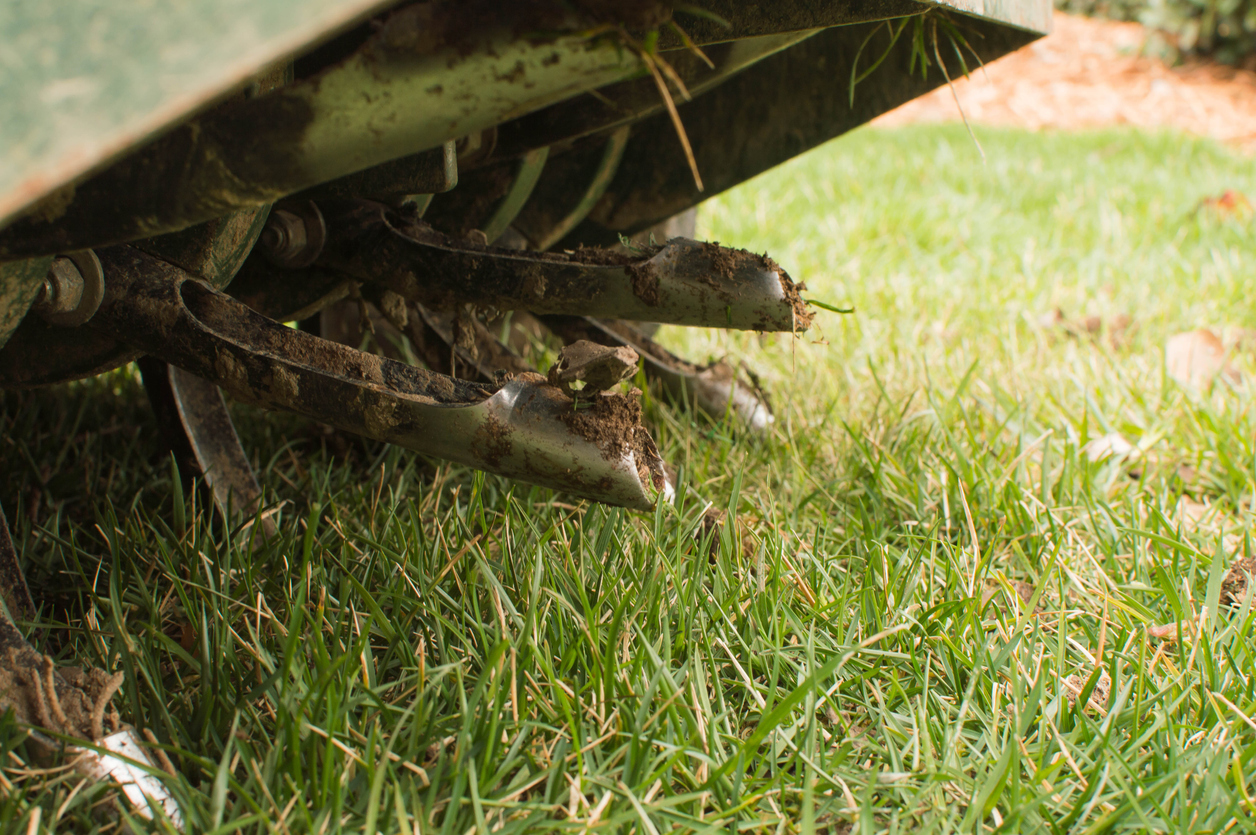
FAQs
Lawn aeration is a little like opening the windows in a stuffy home to make those living inside more comfortable. To aerate a lawn, a pro or a DIYer uses a soil aeration tool to punch holes in the soil to improve delivery of air, water, and nutrients to the dirt and the grass roots, in the process giving those roots room to spread.
The best time to aerate a lawn varies, depending on the type of grass you have and the climate in your region. Aeration needs to be done far less frequently than more regular lawn chores like mowing or fertilizing. Generally, the health of the grass and other clues, such as soil compaction, pooling water, thick thatch, and uneven grass growth, will tell you when your lawn needs aeration.
A lawn aerator creates holes in the grass and soil below. The best type of lawn aerator is a plug aerator, which pulls up tiny cores, or plugs, from the soil to create space for air, water, and root growth. Although in the short term you will end up with tiny holes in the lawn and soil plugs scattered on the grass, aeration will improve your lawn’s appearance and health.
If you plan to overseed a lawn to fill in spots, you should aerate before seeding. It is best to avoid aerating lawns when they are going into dormancy. So, late summer or early fall are too late for warm-season grasses; it is best to aerate in late spring or early summer. For aerating cool-season grasses, stick to early spring and early fall.
Don’t aerate your lawn when it doesn’t need it. Signs that it’s time to aerate include accumulation of thatch, soil compaction, or poor grass health. Also, do not aerate a lawn that is soggy. After a heavy rain, let the lawn dry out for a few days before aerating. And if you’re planning on laying sod, hold off on aerating until the job is finished.
Mornings work best for aeration, since temperatures are cooler and humidity higher than in the afternoon, giving the soil a little recovery time. Avoid aerating on hot and dry summer days, if possible.
